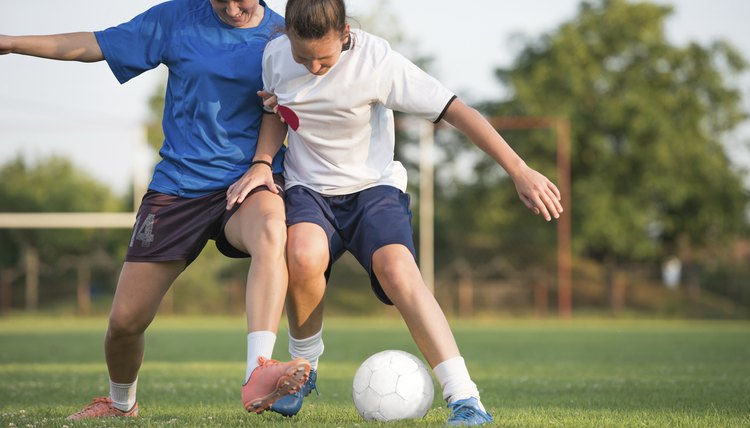What Soccer Position Runs the Most?

Soccer players walk, jog, run and sprint in the course of the 90 minutes of a typical outdoor game. A player at the older youth or adult level may cover five miles per game. And an elite, energetic player such as Kyle Beckerman of Real Salt Lake can manage nearly 10 miles per game. Familiarity with the demands of soccer by position can help you figure out where your skills fit best.
Distance Leaders
Midfielders, who as the name suggests play behind the forwards and in front of the defenders, run the most in a soccer game. Their role is to link the defense and offense. This requires them to run back to make themselves available for passes out of the back, to dribble with the ball up the field and to dish the ball off to forwards or take a shot themselves if they can carry the ball into the penalty area. Thus if your fitness is exceptional, you may well find yourself playing in midfield.
Case Study
Players themselves on teams at the youth and amateur level are well aware that midfielders run the most in soccer. Plenty of scientific data backs up this observation as well. For example, tracking technology at the 2009 Major League Soccer Cup followed midfielder Beckerman. He occupied a defensive center midfielder position and roamed from side to side of the field as well as forward and back to stifle the offense. In the 120-minute game including overtime, Beckerman covered 9.5 miles. The opposing team, the LA Galaxy, featured David Beckham as a right midfielder. He ran an economical 3.3 miles, contributing more with astute passing and an assist than by covering ground.
Surveys
Motion analyses in English, Swedish, Danish and Brazilian soccer leagues have confirmed that midfielders cover the greatest distance. Goalkeepers cover the least distance, unsurprisingly, at about 2.5 miles. Central attacking and holding midfielders such as Beckerman cover the most distance, followed by wing midfielders and wing defenders like Beckham, then strikers and central defenders, notes exercise physiologist Donald Kirkendall in “Soccer Anatomy.” Thus midfielders need tremendous aerobic fitness, especially at the elite level, as measured by the VO2 max test of maximal oxygen uptake.
Sprint Leaders
If you look at the question a different way, while midfielders cover the greatest distance, strikers equal midfielders in time spent at a full sprint, notes pioneering soccer sports scientist Thomas Reilly. Next are center fullbacks, not a surprise since they must defend against the fastest strikers on the opposing team who get past the defense. Teams that emphasize the “direct to goal” style of play expect hard running by all players. And teams that follow the Dutch “total football” style, with all players able to play all positions, may also have a leveling effect on players, such that they show less difference in total amount of running by position, Reilly observes.
References
Writer Bio
An award-winning writer and editor, Rogue Parrish has worked at the Washington Post, the Baltimore Sun and at newspapers from England to Alaska. This world adventurer and travel book author, who graduates summa cum laude in journalism from the University of Maryland, specializes in travel and food -- as well as sports and fitness. She's also a property manager and writes on DIY projects.
